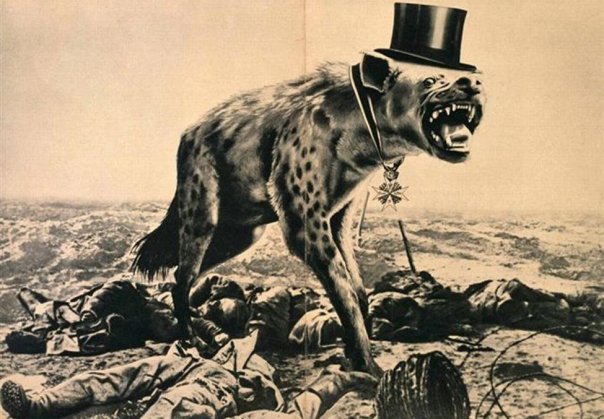Leo Dohmen
28 01 2017Comments : Leave a Comment »
Tags: Leo Dohmen
Categories : 30s, 40s, art, Collage, Culture, photo montage, photography, Uncategorized
Horace Pippin
10 07 2015I love this guy’s work, his story telling, and his humility as an artist.










Comments : 1 Comment »
Tags: Horace Pippin
Categories : 20th Century, 30s, 40s, American Culture, American history, art, Culture, naive art, Uncategorized
Palmer Hayden
7 07 2015I love this guy’s story telling.








Comments : 2 Comments »
Tags: Palmer Hayden
Categories : 20s, 30s, 40s, American Culture, American history, art, Collage, Culture, paintings, Uncategorized
John Heartfield
30 06 2015Comments : Leave a Comment »
Tags: John Heartfield
Categories : 30s, 40s, art, Collage, Culture, photo montage, photography, photos, politics, Uncategorized
Edward Burra
26 05 2015One of the oddest and most interesting artists I have come across.








Comments : Leave a Comment »
Tags: Edward Burra
Categories : 30s, 40s, art, Collage, Culture, entertainment, paintings, surreal, Uncategorized
BONA TIBERTELLI DE PISIS
6 04 2015BONA TIBERTELLI DE PISIS. 1926 – 2000. (Bona de Mandiargues) I hope I’m not talking about 2 artists. (Chalk it up to stupidity.) I was in Paris in the early 1970s which would have been this artist’s prime. Perhaps she walked by me in a book store. Or slapped my face in a cafe. Who knows how close we come to meeting each other in this world.






Comments : 1 Comment »
Tags: BONA TIBERTELLI DE PISIS
Categories : 40s, art, Culture, paintings, surreal, the 50s, the 60s, the 70s, Uncategorized
Joan Miro
6 03 2015Joan Miro was a revolutionary. He did not want to change us, so much as wake us up. We were mud with eyes and we had to open them.
Joan Miró i Ferrà (Catalan: [ʒuˈam miˈɾo]; 20 April 1893 – 25 December 1983) was a Catalan, Spanishpainter, sculptor, and ceramicist born in Barcelona. A museum dedicated to his work, the Fundació Joan Miró, was established in his native city of Barcelona in 1975, and another, the Fundació Pilar i Joan Miró, was established in his adoptive city of Palma de Mallorca in 1981.
Earning international acclaim, his work has been interpreted as Surrealism, a sandbox for the subconscious mind, a re-creation of the childlike, and a manifestation of Catalan pride. In numerous interviews dating from the 1930s onwards, Miró expressed contempt for conventional painting methods as a way of supporting bourgeois society, and famously declared an “assassination of painting” in favour of upsetting the visual elements of established painting. (Wikipedia)
Comments : 2 Comments »
Tags: joan miro
Categories : 30s, 40s, abstract art, art, Culture, paintings, surreal, Uncategorized
Grete Stern
11 02 2015Like many women artists Grete Stern had an interesting life. Choosing the life of an artist was difficult for men, but for women there were many more obstacles including the chauvinism of their colleagues.
Grete Stern was an emigre from Nazi Germany who moved to England and finally to Argentina. The images in her work grow into new images. I find her work exciting and very clever. If I had seen her work when I was young I would have said that she had a great influence on me. Many of her(visual) ideas are similar to my own. But I only discovered her recently.Although much of her work had a commercial/utilitarian purpose, illustrating dreams of readers of a woman’s magazine, the images stand on their own without explanation.
Comments : 1 Comment »
Categories : 30s, 40s, art, Collage, Culture, fantasy, photo montage, photography, photos, surreal, Uncategorized
Alfred Eisenstaedt
2 01 2015Alfred Eisenstaedt (December 6, 1898 – August 23, 1995) was a German-born American photographer and photojournalist. One of the most prolific photographers of the twentieth century, he began his career in pre-World War II Germany, and after moving to the U.S., achieved prominence as a staff photographer for Life Magazine, which featured more than 90 of his pictures on its covers with over 2,500 photo stories published.
Among his most famous cover photographs was the V-J Day celebration in New York City of “an exuberant American sailor kissing a nurse in a dancelike dip [that] summed up the euphoria many Americans felt as the war came to a close.”[1] Eisenstaedt was “renowned for his ability to capture memorable images of important people in the news, including statesmen, movie stars and artists” and for his candid photographs, taken with a small 35mmLeica camera and typically with only natural lighting.[1]
Comments : Leave a Comment »
Tags: Alfred Eisenstaedt
Categories : 30s, 40s, art, Culture, entertainment, fantasy, movies, photography, photos, portraits, Uncategorized
Jaromir Funke
31 12 2014Even a bottle of wine looks like the Gestapo. Suspicion and paranoia seem to whisper in every photo. (Or perhaps I am reading into his photographs because he worked before and during WW2.
Comments : Leave a Comment »
Tags: Jaromir Funke
Categories : 30s, 40s, abstract art, art, Culture, photo montage, photography, photos, still life, Uncategorized

















































Recent Comments